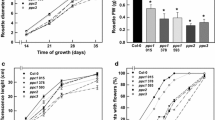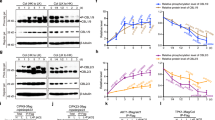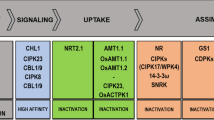Abstract
Water deficit-induced ABA accumulation is an ideal model or “stimulus-response” system to investigate cellular stress signaling in plant cells, using such a model the cellular stress signaling triggered by water deficit was investigated inMaize L. coleoptile. Water deficit-induced ABA accumulation was sensitively blocked by NaVO3, a potent inhibitor both to plasma membrane H+-ATPase (PM-H+-ATPase) and protein tyrosine phosphatase (PTPase). However, while PM-H+-ATPase activity was unaffected under water deficit and PM-H+-ATPase activator did not induce an ABA accumulation instead of water deficit, water deficit induced an increase in the protein phosphatase activity, and furthermore, ABA accumulation was inhibited by PAO, a specific inhibitor of PTPase. These results indicate that protein phosphtases may be involved in the cellular signaling in response to water deficit. Further studies identified at least four species of protein phosphtase as assayed by using pNPP as substrate, among which one component was especially sensitive to NaVO3. The NaVO3-sensitive enzyme was purified and finally showed a protein band about 66 kD on SDS/PAGE. The purified enzyme showed a great activity to some specific PTPase substrates at pH 6.0. In addition to NaVO3, the enzyme was also sensitive to some other PTPase inhibitors such as Zn2+ and MO3 3+, but not to Ca2+ and Mg2+, indicating that it might be a protein tyrosine phosphatase. Interestingly, the purified enzyme could be deactivated by some reducing agent DTT, which was previously proved to be an inhibitor of water deficit-induced ABA accumulation. This result further proved that PTPase might be involved in the cellular signaling of ABA accumulation in response to water deficit.
Similar content being viewed by others
References
Shinozaki, K., Yamaguchi-Shinozaki, K., Gene Expression and signal transduction in water-stress response, Plant Physiol., 1997, 115: 327–334.
Liu, Q., Zhang, Y., Chen, S., Plant protein kinase genes induced by drought, high salt and cold stresses, Chinese Science Bulletin, 2000, 45: 1153–1157.
Neill, S. J., Burnett, E. C., Regulation of gene expression during water deficit stress, Plant Growth Regul., 1999, 29: 23–33.
Leung, J., Giraudat, J., Abscisic acid signal transduction, Ann. Rev. Plant Physiol. Plant Mol. Biol., 1998, 49: 199–222.
Davies, W. J., Zhang, J., Root signals and the regulation of growth and development of plants in drying soil, Ann. Rev. Plant Physiol. Plant Mol. Biol., 1991, 42: 55–76.
Jia, W. S., He, F. L., Zhang, D. P., Cell biological mechanism for triggering of ABA accumulation under water stress inVicia faba leaves, Science In China, Ser. C, 2001, 31: 213–219.
Jia, W. S., Zhang, J., Water stress-induced abscisic acid accumulation in relation to reducing agents and sulhydrl modifiers in maize plant, Plant Cell Environ., 2000, 23: 1389–1395.
Jia, W. S., Zhang, J., Initiation and regulation of water deficit-induced abscisic acid accumulation in maize leaves and roots: Cellular volume and water relations, J. Exp. Bot., 2001, 52: 295–472
Stone, J., Dixon, J. E., Protein tyrosine phosphatases, J. Biol. Chem., 1994, 269: 3132–3133.
Stone, J. M., Walker, J. C., Plant protein kinase families and signal transmission, Plant Physiol., 1999, 108: 451–457.
Guo, Y. L., Roux, S. J., Partial purification and characterization of an enzyme from pea nuclei with protein tyrosine phosphtase activity, Plant Physiol., 1995, 107: 167–173.
Huyer, G., Liu, S., Kelly, J. et al., Mechanism of inhibition of protein-tyrosine phosphatases by vanafate and pervanadate, J. Bio. Chem., 1997, 272: 843–851.
Chiarugi, P., Fiaschi, T., Taddei, M. L. et al., Two vicinal cysteines confer a peculiar redox regulation to low molecular weight protein tyrosine phophatases in response to platelet-derived growth factor receptor stimulation, J. Bio. Chem., 2001, 276: 33478–33487.
Frost, S. C., Lane, M. D., Evidence for the involvement of vicinal sulfhydrl groups in insulin-activated hexose transport by 3T3-L1 adipocytes, J. Bio. Chem., 1985, 260: 2646–2652.
Guo, Y. L., Terry, M. E., Roux, S. J., Characterization of a cytosolic phosphatase from pea plumules having significant protein tyrosine phosphatase activity, Plant Physiol. Biochem., 1998, 36: 269–278.
Xu, Q., Fu, H. H., Gupta, R. et al., Molecular characterization of a tyrosine-specific protein phosphatase encoded by a stress-response gene in arabidopsis, Plant Cell, 1998, 10: 849–857.
Tassoni, A., Antognoni, F., Bagni, N., Polyamine binding to plasma membrane vesicles isolated from zucchini hypocotyls, Plant Physiol., 1996, 110: 817–824.
Chen, P. S., Toribara, T. Y., Warner, H., Microdetermination of phosphorus, Analytical Chem. 1956, 28: 1756–1758.
Quarrie, S. A., Whitford, P. N., Appleford, N. E. J. et al., A monoclonal antibody to (S)-abscisic acid: Its characterization and use in a radio immunoassay for measuring abscisic acid in crude extracts of cereal and lupin leaves, Planta, 1988, 173: 330–339.
Ng, D. H. W., Harder, K. W., Clark-Lewis, I. et al., Nonradioactive method to measure CD45 protein tyrosine phosphatase activity isolated directly from cells, J. Immunol. Methods, 1994, 179: 177–185.
Sheen, J., Ca2+-dependent protein kinases and stress signal transduction in plants, Science, 1996, 274: 1900–1902.
Stone, J. M., Walker, J. C., Plant protein kinase families and signal transmission, Plant Physiol., 1995, 108: 451–457.
Chang, C., Stewart, R. C., The two-component system, Plant Physiol., 1998, 117: 723–731.
Urao, T., Yakubov, B., Satoh, R. et al., A transmembrane hybrid-type histidine kinase in arabidopsis function as an osmosensor, Plant Cell, 1999, 11: 1743–1754.
Author information
Authors and Affiliations
Corresponding author
About this article
Cite this article
Xing, Y., Zhang, S., Wang, Y. et al. Protein tyrosine phosphatase is possibly involved in cellular signal transduction and the regulation of ABA accumulation in response to water deficit inMaize L. coleoptile. Chin.Sci.Bull. 48, 460–465 (2003). https://doi.org/10.1007/BF03183251
Received:
Issue Date:
DOI: https://doi.org/10.1007/BF03183251




